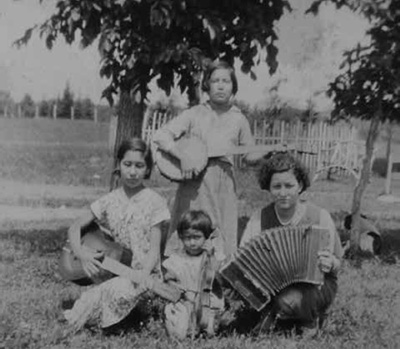“Half and Half”
(Composed by Wally Moon Martin and Albert Slim Martin)
And then now the way he looks, and then now the way he smiles
And now on top of the hill the little people are singing
I just run down the hill, I just run into the water
The salt ship is coming and they are bringing my kin
I just run down the hill, I just run into the water
Jolne’j share your chew even if it’s already chewed
This song was written by two Martin brothers from Listuguj, Quebec, located in Gespe’gewa’gi (“The Last Land”), the seventh and largest district of Mi’kma’ki. Gespe’gewa’gi has been Mi’kmaq and Listuguj traditional territory since time immemorial. Albert (Slim) Martin and Elie Wallace (Wally Moon) Martin were born and raised in the Mi’kmaq community of Listuguj. Both were musically inclined, and self-taught musicians who made a living as song writers and entertainers.
Half and Half was composed of two portions, an English side and a Mi’kmaw side; written to the melody of “Wildwood Flower.” The original song was a recording done by George Jones called “Best Guitar Picker.”
Here is a link to another article written by Joe Wilmot – http://www.aboutourland.ca/resources/migmaq-stories/puglutmu%E2%80%99j. It contains a bit more of the local legend.
Slim Martin and Wally Moon composed the Mi’kmaq portion of the song in the 1960s based on a story shared by the two Mi’kmaq communities in Quebec, Listuguj and Gesgapegiag. As children they were taught there were little people who lived on top of the Appalachian Mountains between Listuguj and Gesgapegiag. During the night time while all were asleep, they used to slide down the mountain to play tricks on the animals or people. Some of the tricks they were best known for was braiding horses’ tails or stealing pies off window sills while they were cooling. After all, the “puglutmu’j” loved their sweets. The body of water they refer to in this song is known as the Bay of Chaleur. Today, you can still see the skid marks running down the side of the mountain side between the towns of Nouvelle and Carleton.
The original recording of this song “Half and Half” can be found on the album called The Mighty Mohawks Capture Country. It is called The Puglutmaj.
- What do you think this song might be about?
- Who are the kin?
- Why do you think this is called ‘The Little People’s Song’?
- Is it a serious song?
Can you make up a song about a river, lake or stream that you like visiting?





